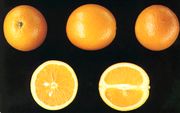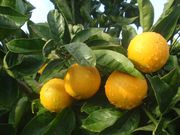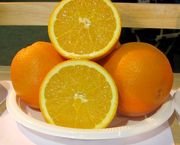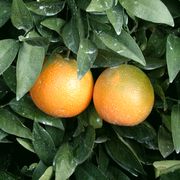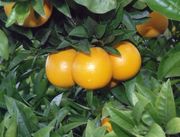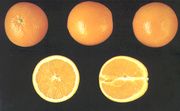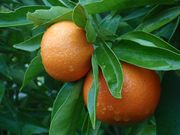|
|||||||||||
| |
Select any of 50
available languages!
|
 |
|||||||||
| Sweet oranges | ||
| Citrus × sinensis |
 |
History The Portugal orange Cultivation Harvest Index of varieties on this page Sweet orange Citrus × sinensis Nucellar embryony Nutritional values Blood oranges |
| 'Jincheng' oranges © Jorma Koskinen |
|
|||||||||||||||||||||||||||||||||
The blood orange page Because this sweet orange page became very heavy and slow to download due to large number of pictures blood oranges have been moved to a page of their own.
| |||||||||||||||||||||||||||||||||||||||||||||||||||||||||
|
Sweet orange |
| LAT | Citrus × sinensis (L.) Osbeck |      |
| Syn | Citrus aurantium var. sinensis L. Aurantium sinense L. |
|
Sweet orange is a medium-sized tree with a rounded top and regular branches; twigs are angled when young, usually with slender, somewhat flexible, rather blunt spines in the axils of the leaves; leaves medium-sized, pointed at the apex, rounded at the base; petioles narrowly winged, articulated both with the twig at the base and with the leaf blade at the tip; flowers in small racemes or singly in the axils of the leaves, medium-sized with 5 petals and 20-25 stamens. Fruits are subglobose, oval or flattened globose; peel thin, tight, not bitter, central axis (pith) solid. Citrus sinensis, the Sweet Orange is probably native to southeastern Asia, in northeastern India or, more likely, in southern China and Indo-China. It has been so widely cultivated for so long that it is no longer known in a truly wild condition. Sweet orange is by far the most widely grown fruit tree in the world and the second most commonly cultivated fruit. Banana, which is not a tree, is the number one fruit, grapes come third with apples in fourth place. But if all citrus fruits are counted together they form the biggest group of cultivated fruit. Sweet orange has intrigued the minds of men long before it had been sighted in medieval Europe. Richard I of England (Richard the Lionheart) spent a year in Palestine from early summer 1191 till late summer 1192 on the third crusade (1187-1192). According to an old tale he visited the orange groves near Jaffa and after his return to England he could not stop describing his experiences and the nocturnal perfumes and sweet tastes he had encountered. However, we do not know the exact type of oranges that were grown there at the time. True sweet oranges came to Europe around 1635 through Portugal (see above). Although it took the sweet orange several centuries to establish its position as one of the world's most common fruits, the increased demand for fresh orange juice and the development of very early and very late maturing varieties have contributed to its present popularity and its year-round availability. |
||
| ENG | Sweet
orange |
|
| FRA | Orange douce, Orange de Malte | |
| GER | Apfelsine | |
| I TA | Arancia | |
| ESP | Naranja (dulce) (fruit), Naranjo de la China (tree) | |
| Photos | © Jorma Koskinen | |
|
|
||
|
Early sweet, blonde and common oranges |
| LAT | Citrus × sinensis ’Comuna’ |  |
Comuna is one of the oldest Mediterranean blonde orange varieties. The origin is not known. There seems to be several closely related strains and similar varieties are known in Italy (Comuna) and Malta (Malta Common). The tree is vigorous and very productive. The seedy fruit is medium-sized to big and very juicy. The mid-season fruit mature in December in Spain. Because of the existence of seedless varieties of higher quality in the same group, the importance of Comuna is slowly diminishing. Salustiana is a limb sport of Comuna |
||
| ENG | Comuna
orange |
|
| Photos | © IVIA OTRI | |
| LAT | Citrus × sinensis ’Jaffa’ |  |
Jaffa (also known as 'Florida Jaffa') was introduced to Florida in 1883 from Palestine, but it does not appear to be quite the same as the original 'Shamouti' variety. Its fruit are small to medium, commercially seedless (0-6 seeds), with a thin, smooth peel. Peel color is yellow as is juice color. The flesh is melting in texture and of very high quality, producing a thick, nectar-like juice. 'Jaffa' usually achieves maturity by Christmas time. Flecks of pigment sometimes occur in the fruit during cooler winter conditions in Texas, so much so that the name 'Jaffa Blood Orange' has been suggested. Disambiguation: See 'Shamouti' (Palestine Jaffa) |
||
| ENG | Jaffa
orange, Florida Jaffa |
|
| FRA | Orange Jaffa | |
| Photo | © Aggie Horticulture TAMU | |
| LAT | Citrus × sinensis ’Marss’ |   |
| Marrs arose as a limb sport of Washington navel in 1927 in Donna, TX. The tree is comparatively small. Its fruit are medium large, round to slightly oblate, with a thin, smooth, moderately thick peel that is easily bruised during harvest. It can contain as many as nine seeds. The peel is yellowish, as is the juice. The flavour is sweet but low in acidity. It matures in late September. |
||
| ENG | Marss
orange |
|
| FRA | Orange Marss | |
| Photos |
© Aggie Horticulture TAMU © C. Jacquemond / INRA |
|
| LAT | Citrus × sinensis ’Parson Brown’ |  |
| 'Parson
Brown' was
discovered
in a grove owned by Parson Brown in Webster, Florida. It was purchased,
propagated and distributed by J.L. Carney between 1870 and 1878. It is
rough-skinned, with pale juice; moderately seedy; of low-to-medium
quality. It was formerly popular in Florida because of its earliness
and long season (October through December), but has been largely
replaced by Hamlin.
It is grown in Texas, Arizona and Louisiana but
is not profitable in California where it matures at the same time
as Washington Navel.
It does not develop acceptable quality in the
tropics.
Parson Brown is also known as: 'Carney', 'Parson' and 'Porter'. |
||
| ENG | Parson
Brown orange |
|
| FRA | Orange Parson Brown | |
| Photo | © Aggie Horticulture TAMU | |
| LAT | Citrus × sinensis ’Pineapple’ |    |
Pineapple orange originated from seedlings planted about 1860 near Citra, FL. It was propagated in 1876 or 1877 under the name of 'Hickory'. The fruit are medium large, somewhat flattened on both ends, with a moderately thick, smooth peel that develops good orange color under cool night conditions. Juice color and quality are very good. It usually contains 15-25 seeds. It succeeds on sour orange rootstock in low hammock land, on rough lemon in light sand. If the crop is allowed to remain too long on the tree, it may induce alternate-bearing. It is the favorite midseason orange in Florida. Pineapple matures in Texas about Thanksgiving. Unfortunately, the name Pineapple has been used in Texas to designate seedy oranges, which includes both Parson Brown and true Pineapple orange. Basically, if the orange in question matures well before Thanksgiving, it isn't Pineapple. Pineapple is also known as: Hickory, Pineapple-156, Ridge Pineapple and Ridge seedling. |
||
| ENG | Pineapple
orange |
|
| FRA | Orange Pineapple | |
| Photos | © C. Jacquemond
/ INRA © CCPP © Aggie Horticulture TAMU |
|
| LAT | Citrus × sinensis ’Salustiana’ |   |
| |
||
Salustiana (Salus), a highly-valued Spanish blonde variety is believed to have originated as a limb sport on a Comuna tree in the garden of a convent. It was called to the attention of Don Salustiano Pallas of nearby Enova, Valencia, and propagated and introduced by him about 1950. Fruit medium-large, subglobose to spherical and virtually seedless. Unusually well-colored at maturity. Rind medium-thick and surface moderately pebbled. The flesh is melting, very juicy and the flavor rich and sweet. Fruit said to hold especially well on tree without much loss of quality. Matures in November (earliest of the Spanish varieties). Tree is vigorous, somewhat upright, medium-large, and productive. Because of its early maturity, seedlessness, and high quality, Salustiano is a highly-regarded variety and has been planted to a considerable extent in Spain and somewhat in Algeria and Morocco. The Spanish Salustiana production in 2006 was 251 600 metric tons, mostly around Valencia, Cordoba and Seville. Both tree and fruit are almost indistinguishable from Cadenera, except that the latter is somewhat flatter in form. Salustiana is much earlier in maturity, however. Also known as: Pallas Salustiana, Salus and Salustiano. Don Salustiano Pallas owns the orange grove in Enova, near Valencia, where the variety originated. |
||
| ENG | Salustiana
orange |
|
| FRA | Orange Salustiana | |
| Photos | (1)
© Jorma Koskinen (2) © C. Jacquemond / INRA |
|
|
|
||
| LAT | Citrus × sinensis 'Shamouti’ |  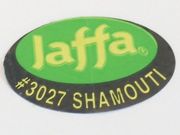  |
| Syn | Citrus × sinensis 'Palestine Jaffa' |
|
Shamouti, also known as 'Palestine Jaffa', is believed to have developed as a branch sport from an earlier variety called Beledi near the town of Jaffa, Palestine in 1844. The peel is thick but comes off easily in segments. The fruit is juicy, with a distinct flavour and of good quality. Unfortunately it has proven to be susceptible to disease outside its native area and recently it has been planted less often than before. It is still the number one variety in Israel and Lebanon, number two in Syria. Israeli producers have sold Shamouti budwood to Spanish growers and they have permission to use the Jaffa name (which is an Israeli trademark) for fruit of Israeli origin. Two later varieties have the same Palestine origin, Jaffa and Joppa, both introduced to the United States in the 1880's. The US Jaffa is often called Florida Jaffa as opposed to this Palestine Jaffa or Shamouti of Israel. The Jaffa orange that is well known in many European countries is usually Shamouti and often the fruit carry a small sticker with the name Jaffa Shamouti (bottom picture). The Jaffa trademark, under which the Israeli citrus producers sell their fruit, covers several other citrus varieties as well and later orange varieties include Jaffa Navel and Jaffa Valencia. See
other Jaffa citrus fruit
Shamouti is also known as: Cyprus Oval, Palestine Jaffa, Ronde and Chamouti Yaffaoui. Disambiguation: See 'Jaffa' (Florida Jaffa) orange |
||
| ENG | Shamouti
orange, Palestine Jaffa, Palestine orange |
|
| FRA | Orange shamouti | |
| Photos | © Jorma Koskinen | |
| Back to sweet orange types | Back to beginning |
| LAT | Citrus × sinensis ’Campbell nucellar Valencia’ |   |
This Campbell nucellar seedling is indistinguishable from Campbell, but is more vigorous and thornier. The original Campbell old budline fruit is indistinguishable from Valencia, but the tree exhibits certain consistent, discernible differences in vigor and behavior in comparison with Valencia. In trials of the two parent clones and of nucellar clonal budlines of comparable age, the trees of Campbell have consistently been more vigorous, thornier, larger, broader-topped, and slower to come into bearing than Valencia. The fruit has also been slightly lower in juice content than Valencia in the coastal region. The parent tree came to light about 1942 in the Early Campbell orchard near Santa Ana, which was planted in 1871. During recent decades Campbell has been planted considerably in California. More recently, this Campbell nucellar budline has achieved popularity. Season: March to July Campbell Valencia is also know as: Fawcett Campbell, Valencia Campbell |
||
| ENG | Campbell
Valencia orange |
|
| FRA | Orange Campbell | |
| Photos | © UCR Citrus
Variety Collection © CCPP |
|
| LAT | Citrus × sinensis ’Cutter Valencia’ |   |
This California nucellar seedling was derived about 1935 by H. S. Fawcett of the Citrus Research Center, Riverside, from an outstanding old Valencia tree in the J. C. Cutter orchard at Riverside. This seedling budline was released in 1957 and is currently popular. Cutter is exceptionally vigorous and thorny and somewhat slow to come into bearing. Season of ripeness: March to July |
||
| ENG | Cutter
Valencia orange |
|
| FRA | Orange Cutter Valencia | |
| Photos | © CCPP © UCR Citrus Variety Collection |
|
| LAT | Citrus × sinensis ’Frost nucellar Valencia’ |   |
Frost Valencia is a nucellar seedling derived about 1915 by H. B. Frost of the Citrus Research Center, Riverside, and released in 1952. Exceptionally vigorous and productive, it is the oldest of the California nucellar budline selections and used to be the most popular. It has lost some of its popularity in recent years. Season: March to July |
||
| ENG | Frost
Valencia orange |
|
| FRA | Orange Frost Valencia | |
| Photos | © UCR Citrus Variety Collection | |
| LAT | Citrus × sinensis ’Harward Late Valencia’ |   |
Harward Late, a New Zealand variety is a seedling of Valencia with fruit that is indistinguishable from its parent. The tree is vigorous, large, and productive, and its overall performance is superior in New Zealand. Harward Late originated at Tauranga and probably represents a clonal budline of nucellar seedling origin. This is a budline selection of Harward Late made by John Wilson, in Keri Keri, NZ. The fruit mature from November to February in New Zealand. Tree is moderately vigorous with rounded bushy habit and a consistantly high yield. Fruit are medium to large; globose to oblique in shape; the rind thick (7-8 mm); moderately easy to peel and segment. Flesh is orange when mature; moderately sweet (up to 6 seeds per fruit). This is a good quality late maturing Valencia orange. Season: March to July |
||
| ENG | Harward
Late Valencia orange |
|
| FRA | Orange Harward Late | |
| Photo | © UCR Citrus Variety Collection | |
| LAT | Citrus × sinensis ’Olinda' nucellar Valencia |   |
| |
||
Olinda originated in California in 1939 and was released for sale in 1957. Olinda has aroused the interest of growers because in some cases it has proven to give a harvest twice the size of Valencia. Nucellar Olinda adapts well to varying conditions. It tolerates high heat and dryness better than other varieties and has shown promise in experiments in Saudi Arabia. The fruit are smooth, of fine quality, thin-skinned and full of juice. Season: March to July |
||
| ENG | Olinda
Valencia orange |
|
| FRA | Orange Olinda Valencia | |
| Photo | © UCR Citrus Variety Collection | |
| LAT | Citrus × sinensis ’Rhode Red Valencia’ | 
|
Rhode Red has deep orange rind, flesh and juice. It matures at the same time as other Valencias. Only real difference from other Valencias is the deep flesh color See: > Light blood oranges |
||
| ENG | Rhode
Red Valencia orange |
|
| FRA | Orange Rhode Red | |
| Photo | © Jorma Koskinen | |
| LAT | Citrus × sinensis ’Cotidian Valencia’ |     |
| |
||
| Cotidian Valencia is
a variegated form of Valencia orange. The fruit taste like ordinary
Valencias. Variegated forms of citrus trees have been known for centuries. The reasons why variegated forms or mutations happen are not known yet. Variegated forms appear in practically all citrus types. Variegation can happen both in leaves and fruit. In leaves variegation can be total or partial. Especially in sweet oranges the variegation is not always complete. In young plants the variegation is usually stronger and when the tree grows and starts to set fruit the variegation sometimes partially disappears and the leaves can return to full green state. In sweet orange fruit the variegation is clearly visible only when the fruit are immature and usually disappears towards maturity. In certain types the variegation is accomppanied by furrowing of the rind on the darker parts of the skin. The furrows remain also when the fruit colour has broken to full orange. Variegated plants are often smaller and less productive than other varieties. The cause of this is not yet known but it can be due to chlorophyll deficiency since the variegation pattern includes less dark green leaf portions. Photosynthesis, the assimilation of sunshine, water and chlorophyll to form sugars that plants need to grow mainly happens in the green parts of a plant. Many variegated citrus plants are popular dooryard trees and container plants because of their decorative value and edible fruit. See also: Variegated sour orange |
||
| ENG | Cotidian
variegated orange |
|
| FRA | Orange Cotidian panachée | |
| Photo | (1) © Jorma Koskinen (2-3) © Gene Lester (4) Megan Lynch © 2008 |
|
| Back to sweet orange types | Back to beginning |
| Early navel oranges |
| Back to sweet orange types | Back to beginning |
| Mid-season navel oranges |
| LAT | Citrus × sinensis ’Cara Cara’ | 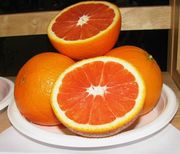
|
Cara Cara is a blood orange. It is discussed in >> Light blood oranges. Cara Cara is also known as: Red Navel |
||
| ENG | Cara
Cara navel orange |
|
| FRA | Orange Red Navel | |
| Photo | © Joe Real | |
| LAT | Citrus × sinensis ’Fukumoto’ |    |
Fukumoto navel orange selection was introduced into California from Japan via the USDA Glenn Dale quarantine facility in 1983. S. Fukumoto, from Kokawa-cho in Japan was the first to grow it in Wakayama Prefecture. This early maturing navel orange reaches legal maturity three to four weeks before Washington navel and is one of the earliest to reach color-break. One of its most outstanding characteristics is the deep reddish rind color. The fruit are harvested from mid October to late December in California. Fukumoto trees tend to be smaller and appear to produce more chimeras than most navel orange selections. Another major concern is the decline of Fukumoto trees grown on C-35 citrange and Carrizo citrange rootstocks. Trees propagated on Carrizo exhibit symptoms of foamy bark rot syndrome which includes lanky zigzag shoot growth, with development of abnormally large leaves and oozing of gum at the base of shoots and through splits in the bark at the crotches of branches. Fukumoto trees propagated on C-35 have symptoms that are more typical of a genetic rootstock/scion incompatibility. These symptoms have also been observed when Fukumoto is grown on Swingle citrumelo rootstock, but not when grown on Sour orange or Volkameriana rootstocks. |
||
| ENG | Fukumoto
navel orange |
|
| FRA | Orange Fukumoto | |
| Photo | (1) © Jorma Koskinen (2) © CCPP (3) © Joe Real |
|
| LAT | Citrus × sinensis 'New Hall' nucellar navel |   |
Newhall nucellar navel orange is a seedling nucellar selection that originated from the old budline Newhall, which in turn originated as a limb sport of a Washington navel orange in the Duarte area and was selected by Paul Hackney of Newhall Land and Water Company of Piru. The fruit of Newhall mature slightly earlier and are slightly smaller in size with deeper rind color and flesh color than Washington navel orange. Newhall navel orange trees are somewhat less vigorous and have leaves that are slightly darker in color than Washington navel orange trees. New Hall navel orange is also known as Newhall and Naveline. |
||
| ENG | New
Hall orange |
|
| FRA | Orange New Hall | |
| Photo | © CCPP © IVIA OTRI |
|
| LAT | Citrus × sinensis ’Washington Navel’ |     |
| |
||
Washington Navel is either identical with the Brazilian 'Bahia' navel or a close mutant of it. It was imported from Brazil to Washington in 1870 and developed for release in Riverside, California. Washington Navel is the second most important orange variety in the world after Valencia. It is the leading variety in Brazil, California, Paraguay, South Africa, Australia and Japan. The large exceptionally delicious round seedless fruits are rich in flavour and have a slightly pebbled orange rind that is easily peeled. The Washington navel is early in maturity, at its best in the late autumn to winter months, but will hold on the tree for several months beyond maturity and stores well. The original source of budwood for this variety, the Parent Washington from 1873 is still alive in Riverside and produces fruit. It was 134 years old in 2007. The picture in the middle was taken in 2005. There is an interesting slideshow by Roistacher C.N. at Ecoport telling the story of the tree. Tasting notes 04 Feb 2011: The fruit was medium yellow and had a thick rind that came off easily. The segments were seedless, loose, very juicy and very sweet. The sugar to acid balance was on the sugary side but had enough acids to make a pleasing citrus flavour. The texture was firm but melting. All in all one of the best oranges to eat fresh. |
||
| ENG | Washington
Navel Orange, Bahia orange Seedless sweet orange, Loose-skinned sweet orange |
|
| FRA | Orange Washington Navel, Orange Bahia | |
| Photos | (1,) © C. Jacquemond
/ INRA (2) © Roistacher C.N. (3) © Joe Real (4) © Jorma Koskinen |
|
| Back to sweet orange types | Back to beginning |
| Late navel oranges |
| LAT | Citrus × sinensis |  Autumn Gold  Barnfield  Chislett  Powell  Wiffen |
| 'Autumn Gold' 'Barnfield' 'Chislett' 'Powell' 'Wiffen' |
||
A number of new late-maturing navel orange selections were identified in Australia in the late 1980's and early 1990's and five of them were sent for evaluation to the CCPP in California and were later released for propagation. Autumn Gold, Barnfield, Chislett, Powell and Wiffen are new late maturing navel orange varieties. They are patented, propietary cultivars owned by their original Australian selectors who have licensed the propagation rights to various Californian nurseries. Currently these varieties are propagated for planting in the UC-Riverside CVC and commercially available from the Citrus Clonal Protection Program (CCPP). Autumn Gold was originally selected by Jack Pollock, Mourquong, NSW, Australia, circa 1950s; apparently a sport of Washington navel; also known as Pollock Late Navel. Barnfield was first selected by Wayne Barnfield, Ellerslie, NSW, Australia, circa 1985. It is apparently a sport of Washington navel; said to have good size and carry well on tree without chemicals until June. Chislett was first selected by N.A. Chislett, Kenley, Victoria, Australia, circa 1986 and is a sport of Washington navel. Powell was first selected by Clive Neil Powell, Curlwaa, NSW, Australia, circa 1978; apparent sport of Washington navel. Wiffen navel orange was found in early 1980s on Wiffen's property, near Nangiloc Victoria Australia. It is said to mature at about the same time as and to hang on the tree as well as 'Lane Late', but to have more solids and juice content and lower granulation late in the season. A five-year follow-up study "New late-season navel orange varieties evaluated for quality characteristics" was conducted at the UC-Riverside CVC in 1997-2001. It gives a closer look at the varieties and their slightly differing characteristics. |
||
| ENG | New
late season navel oranges |
|
| Photos | © UCR Citrus Variety Collection | |
| LAT | Citrus × sinensis ’Lane Late’ |   |
Discovered on the property of Lindsay Lane at Curlwaa, New South Wales, Australia in 1954. Presumed to be a limb mutation of Washington navel. Lane Late navel orange is a late maturing navel orange and was the first of a number of late maturing Australian navel oranges that are either bud sport or limb mutation selections of Washington navel. The tree characteristics are very similar to those of Washington navel orange. The fruit is of similar size and shape, but it has a smoother peel and a slightly smaller navel. The fruit matures four to six week later than the Washington navel orange and stores on the tree for several months after reaching maturity before the quality deteriorates. A five-year follow-up study "New late-season navel orange varieties evaluated for quality characteristics" was conducted at the UC-Riverside CVC in 1997-2001. It compares Lane Late and a number of newer late navel varieties. |
||
| ENG | Lane
Late navel orange |
|
| FRA | Orange Lane Late | |
| Photo | © CCPP © Jorma Koskinen |
|
| Back to sweet orange types | Back to beginning |
| Sweet orange hybrids |
| Nucellar embryony
Nucellar embryony (notated Nu+) is a form of seed reproduction that occurs in many citrus varieties. During the germination of seeds from plants that possess this genetic trait, the nucellar tissue which surrounds the embryo sac in the ovule can produce additional embryos (polyembryony) which are genetically identical to the parent plant. These nucellar seedlings are essentially clones of the parent. By contrast, zygotic seedlings are sexually produced and inherit genetic material from both parents. Nucellar embryony is important to the citrus industry, as it allows for the production of uniform rootstock which yields consistent results in fruit production. However, this trait can interfere with progress in cross-breeding. Most commercial scion varieties produce mainly nucellar seedlings which do not inherit any of the traits of the "father" plant. (Wikipedia) Roose, Mikeal: Molecular Genetic Analysis of Nucellar Embryony in Citrus. Citrus Research Board 2000 Annual Report. |
| Back to sweet orange types | Back to beginning |
Nutritional values
The folllowing nutritional values reflect the average values of a 'Valencia' or 'Washington Navel' orange: Food Value Per 100 g of Edible Portion |
|
|
Fruit (fresh) |
Juice (fresh) |
Juice (canned, unsweetened, undiluted) |
Frozen concentrate (unsweetened, undiluted) |
Juice (dehydrated) |
Orange Peel (raw) |
|
Calories |
47-51 |
40-48 |
223 |
158 |
380 |
|
|
Moisture |
86.0 g |
87.2-89.6 g |
42.0 g |
58.2 g |
1.0 g |
72.5% |
|
Protein |
0.7-1.3 g |
0.5-1.0 g |
4.1 g |
2.3 g |
5.0 g |
1.5 g |
|
Fat |
0.1-0.3 g |
0.1-0.3 g |
1.3 g |
0.2 g |
1.7 g |
0.2 g |
|
Carbohydrates |
12.0-12.7 g |
9.3-11.3 g |
50.7 g |
38.0 g |
88.9 g |
25.0 g |
|
Fiber |
0.5 g |
0.1 g |
0.5 g |
0.2 g |
0.8 g |
|
|
Ash |
0.5-0.7 g |
0.4 g |
1.9 g |
1.3 g |
3.4 g |
0.8 mg |
|
Calcium |
40-43 mg |
10-11 mg |
51 mg |
33 mg |
84 mg |
161 mg |
|
Phosphorus |
17-22 mg |
15-19 mg |
86 mg |
55 mg |
134 mg |
21 mg |
|
Iron |
0.2-0.8 mg |
0.2-0.3 mg |
1.3 mg |
0.4 mg |
1.7 mg |
0.8 mg |
|
Sodium |
1.0 mg |
1.0 mg |
5 mg |
2 mg |
8.0 mg |
3.0 mg |
|
Potassium |
190-200 mg |
190-208 mg |
942 mg |
657 mg |
1,728 mg |
212 mg |
|
Vitamin A |
200 I.U. |
200 I.U. |
960 I.U. |
710 I.U. |
1,680 I.U. |
420 I.U. |
|
Thiamine |
0.10 mg |
0.09 mg |
0.39 mg |
0.30 mg |
0.67 mg |
0.12 mg |
|
Riboflavin |
0.04 mg |
0.03 mg |
0.12 mg |
0.05 mg |
0.21 mg |
0.09 mg |
|
Niacin |
0.4 mg |
0.4 mg |
1.7 mg |
1.2 mg |
2.9 mg |
0.9 mg |
|
Ascorbic Acid |
45-61 mg |
37-61 mg |
229 mg |
158 mg |
359 mg |
136 mg |
Source: Julia F. Morton Fruits of Warm Climates | ||||||
On the blood orange page Because this sweet orange page became very heavy and slow to download due to large number of pictures blood oranges have been moved to a page of their own.
| |||||||||||||||||||||||||||||||||||||||||||||||||||||||||||||||
| Back to sweet orange types | Back to beginning |
e-mail to Citrus Pages
|
|
Page up-dated 22 March 2011
http://users.kymp.net/citruspages/sweetoranges.html







